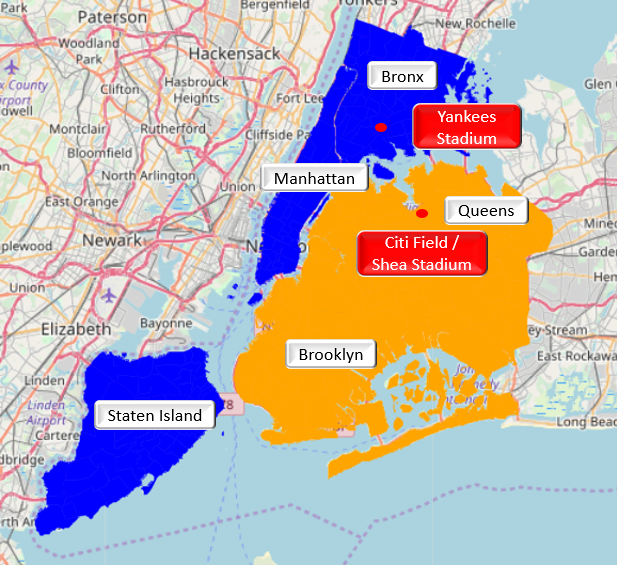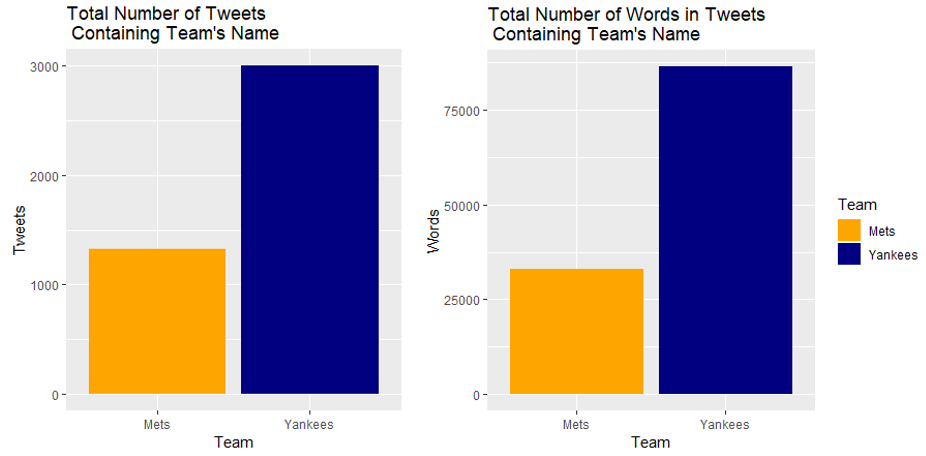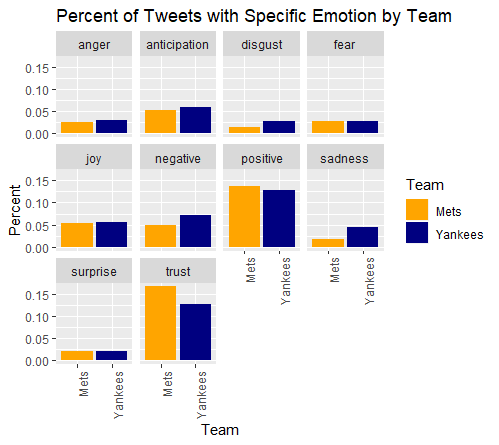American League or National League: Who Owns New York City?
This article was written by Gabriel Costa - Dusty Turner
This article was published in Spring 2019 Baseball Research Journal
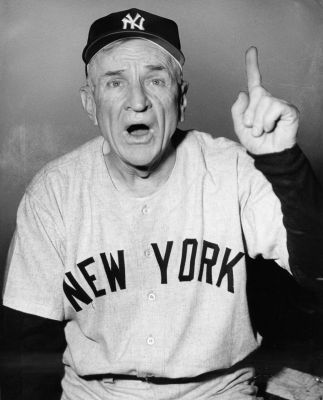 In the spring of 2017, Quinnipiac University put out a poll that led the media to proclaim that New York was (back to being?) a “National League city” because, although the poll showed the Yankees holding a 48-43% preference among fans upstate, in the city the poll swung 45-43% in favor of the Mets.1At about the same time, a local sports radio talk show host made a comment to effect that, while the Yankees presently “owned” New York, that was not always the case and that in times past, New York had been a “National League” city. Setting aside for a moment that the Quinnipiac poll had a margin of error greater than the 2% Mets lead that led to the proclamation, this got us to thinking about whether there was some way to measure when The Big Apple was indeed dominated by fans of the Senior Circuit and when fans of the American League (read: Yankees) were in the majority.
In the spring of 2017, Quinnipiac University put out a poll that led the media to proclaim that New York was (back to being?) a “National League city” because, although the poll showed the Yankees holding a 48-43% preference among fans upstate, in the city the poll swung 45-43% in favor of the Mets.1At about the same time, a local sports radio talk show host made a comment to effect that, while the Yankees presently “owned” New York, that was not always the case and that in times past, New York had been a “National League” city. Setting aside for a moment that the Quinnipiac poll had a margin of error greater than the 2% Mets lead that led to the proclamation, this got us to thinking about whether there was some way to measure when The Big Apple was indeed dominated by fans of the Senior Circuit and when fans of the American League (read: Yankees) were in the majority.
We will investigate this question with both subjective and quantitative approaches. We will take a look at temporal (historical), spatial (geographical), and social (Twitter) aspects of this issue. We will then consider some objectively measurable quantities (victories, attendance figures, head-to-head competitions, social buzz, etc.) to arrive at a plausible conclusion.
HISTORY AND SUBJECTIVE ANALYSIS
In 1903 three major league teams played within the five boroughs which now comprise New York City. The Giants, Yankees (also known as the Highlanders), and the Dodgers (also called the Robins and the Superbas) all vied for local fans. John McGraw ruled his “Jints” with an iron hand and won a number of pennants and a World Championship (1905). Whether the Dodgers (one pennant) or the Yankees (no pennants) were the second-favorite team in town is immaterial. The New York Giants ruled New York. From 1903 till 1919, New York was a National League City.
At that point, one could not easily envision McGraw’s Giants succumbing to any challenge in the foreseeable future. In fact, these very Giants would win four successive pennants (1921–24) with world titles in 1921 and 1922. (Who could have predicted that they would not win another World Series for over three decades?)
But Babe Ruth ushered in the Roaring Twenties and his 1920 Yankees would draw over 1,000,000 fans, in the Giants’ own Polo Grounds, no less. The Bambino would hit 54 home runs, outhomering 14 of the remaining 15 Major League teams. Ruth did not dominate the sport; he transcended the game. He did even better in 1921, and everybody wanted to see The Babe.
The die was cast. McGraw wanted the Yankees to leave the Polo Grounds, which they did in 1923 for a grand new stadium which would only solidify the position of the Yankees in the hearts of New Yorkers.
Then came Lou Gehrig. In 1925, the Iron Horse began a streak without missing a game for a decade and a half. In 1936, Joe DiMaggio came aboard, and would lead the Yankees to four straight World Series titles. Even with the likes of Carl Hubbell and Mel Ott … from 1920 till 1939, New York was an American League City.
From 1940 through the late 1950s, the three New York teams dominated post-season play, especially the Dodgers and the Yankees. The Bombers were nearly unbeatable in October. And heated debates on street corners throughout the boroughs about the three New York City center fielders—Willie, Mickey, and The Duke—were reflective of the passion New Yorkers had for baseball. During this period, one is tempted to say that New Yorkers were really aligned with their boroughs, giving the National League a 2-1 edge over the Junior Circuit. However, the attendance figures don’t tell the whole story, especially in light of the fact that the Dodgers and Giants would soon abandon New York for greener pastures. For now, let’s say that New York was pretty much split on this question from 1940 till 1957.
The year was 1958. With the Dodgers now in Los Angeles and the Giants now in San Francisco, New York was clearly an American League City from 1958 till 1961, with the Yankees winning three Pennants and two World Series in these four years.
The same was also true in both 1962 (Yankees were World Series winners against the Giants) and 1963 (they lost the World Series to the Dodgers) …and possibly in 1964 (and they lost again, this time to the St. Louis Cardinals). New York was still an American League City. This was true even though the National League had returned to New York with the birth of the Mets in 1962.
But 1964 was also a year of transition. The Yankees fired manager Yogi Berra after losing the World Series (after which Berra promptly went to the Mets). The Yankees were getting old with icons like Mickey Mantle and Whitey Ford showing signs of their age. The hallowed House That Ruth Built, Yankee Stadium, was also showing its age, while the New Breed (as the Mets were called) moved from the venerable Polo Grounds to Shea Stadium, a ballpark with no posts or girders to obstruct the vision of the fans.
As time went on, the Mets were slowly getting better and better, while the Yankees kept getting worse and worse. The Amazin’s (as the Mets were also called) won the World Series in 1969, under the tutelage of Dodgers legend Gil Hodges and nearly won another world title in 1973 under Yankees icon Yogi Berra. From 1965 till 1973, New York was a National League City.
But the pendulum was swinging back because of a bombastic shipbuilder by the name of George M. Steinbrenner. The Boss would become the principal owner of the Yankees and would not quit until his Bombers were back on top of the heap. From 1973 thru 1981, the Yankees won four pennants and two World Championships. His “Bronx Zoo” teams, Billy Martin, Thurman Munson, Reggie Jackson, et al, provided fodder for the back page of the New York Daily News virtually every day, and twice on Sundays. In a journalistic sense, the Mets did not even exist. From 1974 till the early 1980s, New York was an American League City.
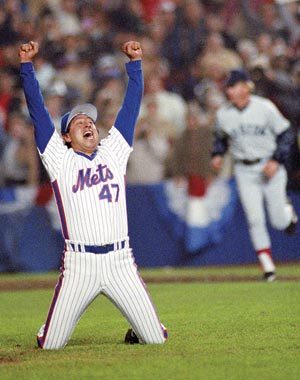 The pendulum came back again in the early 1980s. With superstars like Dwight Gooden, Darryl Strawberry, Keith Hernandez and Gary Carter, the Mets would win the World Series in 1986. They owned New York, not only that year, but for the next few years as well. However, they were to win no more pennants until 2000. The Yankees actually had the best record in the major leagues for that decade. However, neither New York team wore the world crown from 1987 onwards … so, primarily based on the second half of the decade, New York was a National League City from 1982 until 1989.
The pendulum came back again in the early 1980s. With superstars like Dwight Gooden, Darryl Strawberry, Keith Hernandez and Gary Carter, the Mets would win the World Series in 1986. They owned New York, not only that year, but for the next few years as well. However, they were to win no more pennants until 2000. The Yankees actually had the best record in the major leagues for that decade. However, neither New York team wore the world crown from 1987 onwards … so, primarily based on the second half of the decade, New York was a National League City from 1982 until 1989.
Over the next seven years, the Mets finished only once with a winning season (1990). The Yankees did not start out well, but they began to turn the corner in 1993, and actually led the American League East division in 1994, only to be stymied by a work stoppage. The tide was turning back to the American League. However, at this point, let us say that New York was pretty much split on this question from 1990 till 1995.
All of this was to change in 1996. George Steinbrenner was still at the controls and players like Derek Jeter, Mariano Rivera, Jorge Posada and the like would bring a new era of winning to the Yankees. They would win World Series titles in 1996, 1998, 1999, 2000, and 2009.
Regarding the 2000 Series, New York would host a Subway Series for the first time since 1956. The Yankees went on to defeat the Mets in five games, with most media reporting that there seemedto be more Yankees fans at Shea Stadium than Mets followers at Yankee Stadium.2
In any event, from 1996 to the present, New York is an American League City.
The following table summarizes our subjective calculations:
TABLE 1: NEW YORK CITY PREFERENCES
|
YEARS |
CITY PREFERENCE |
YEARS |
|
1903-1919 |
NL |
17 |
|
1920-1939 |
AL |
20 |
|
1940-1957 |
Even |
18 |
|
1958-1964 |
AL |
7 |
|
1965-1973 |
NL |
9 |
|
1974-1981 |
AL |
8 |
|
1982-1989 |
NL |
8 |
|
1990-1995 |
Even |
6 |
|
1996-2017 |
AL |
22 |
Note that from a geographical point of view, the boroughs of Queens and Brooklyn seem to be Mets territory while the Bronx, Staten Island, and Manhattan have more Yankees rooters. Long Island pretty much belongs to the Mets while southern Connecticut and northern New Jersey is saturated with Bombers. Measuring fanship by ticket sale location versus team predominantly preferred on Facebook yields slightly different results, but the map below depicts the general fanship borders by borough.3, 4
NEW YORK MAP OF STADIUMS AND BOROUGHS
Figure 1: New York City Map Showing Stadiums and their Proximity to each Borough5
(Click image to enlarge.)
QUANTITATIVE ANALYSIS
It is time now to switch gears and to crunch the numbers. From this quantitative approach, we will not only consider the “league-wise head-to-head” win-loss records of the four teams in questions (New York Giants, Brooklyn Dodgers, New York Yankees, and New York Mets), but also attendance figures. While fans do not always turn out for a winner, history has clearly indicated that when teams win, they are more likely to draw more fans than when they lose.
It pretty much follows, then, that if a team is better on the field and more fans are coming to the home field of the better of two teams (or the best out of three teams), it seems plausible to conclude that the league which is represented by this team is the preferred league in the city.
The Win-Loss records of the teams in question were easy to obtain.6The following three tables reveal how the New Yorkers performed on the field.
TABLE 2: PENNANTS AND WORLD SERIES
|
YEARS |
TEAM |
PENNANTS |
WORLD SERIES |
|
1903-1957* |
NY Giants |
15 |
4 |
|
1903-1957 |
BRO Dodgers |
9 |
1 |
|
1903-2017 |
NY Yankees |
40 |
27 |
|
1962-2017 |
NY Mets |
5 |
2 |
*No World Series in 1904 or 1994.
TABLE 3: YANKEES VS NY NATIONAL LEAGUE IN WORLD SERIES
|
OPPONENT |
WORLD SERIES WON |
WORLD SERIES LOST |
|
NY Giants |
4 |
2 |
|
BRO Dodgers |
6 |
1 |
|
NY Mets |
1 |
0 |
TABLE 4: INTERLEAGUE PLAY
|
TEAM |
WINS |
LOSSES |
|
NY Yankees |
66 |
46 |
|
NY Mets |
46 |
66 |
If New Yorkers love a winner, then, based on the data above, the Big Apple is clearly an American League city.
We next took a look at the attendance figures. Unlike the Win-Loss records, the attendance figures were much harder to analyze due to a number of factors, especially when trying to compare the National League versus the American League. This was primarily due to the fact that until 2000, the Senior Circuit used turnstile numbers while their counterparts in the American League used ticket sales.7
Most probably, all things being equal, the National League’s method of reckoning would have given them a figure less than what would have been reported for the American League. For example, if, in 1990, the Mets reported 2,000,000 as their season’s attendance and the Yankees reported the same number, chances are the Mets would have sold more than 2,000,000 tickets. But by how many? That’s the question.
What we decided to do was to adjust National League attendance figures from 1903 through 1999, by multiplying them by a generous factor of 1.1. So, in the example above, the 1990 Mets would have had an Adjusted Attendance of 2,000,000 *1.1 = 2,200,000. This would mean that 200,000 tickets went unused.8
The following tables summarize the New York City attendance figures from 1903 through 1957, (Giants, Dodgers, and Yankees) and from 1962 through 2017 (Mets and Yankees).9
TABLE 5: NEW YORK CITY ATTENDANCE FIGURES, 1903–57
|
TEAM |
ATTENDANCE |
ADJUSTED ATTENDANCE |
YEARS LEADING CITY |
|
NY Giants |
42,831,882 |
47,115,070 |
21 |
|
BRO Dodgers |
38,939,115 |
42,833,027 |
7 |
|
NY Yankees |
53,164,456 |
53,164,456 |
27 |
TABLE 6: NYC ATTENDANCE FIGURES, 1962–2017
|
TEAM |
ATTENDANCE |
ADJUSTED ATTENDANCE |
ATTENDANCE |
ATTENDANCE |
YEARS LEADING CITY |
|
NY Yankees |
70,519,850 |
70,519,850 |
64,822,855 |
135,342,705 |
35 |
|
NY Mets |
69,929,524 |
76,922,476 |
49,214,224 |
126,136,700 |
21 |
These numbers pretty much speak for themselves, no?
A final comment about league preference: the fact is that from 1903 through 1957, the National League played approximately twice as many games as the Yankees did in New York City, because there were two National League teams in residence. This would seem to give an enormous edge to the Senior Circuit … yet, the numbers do not seem to bear this out.
To be sure, there have been ebbs and flows, and there were times when McGraw’s Giants and the Amazin’ Mets owned the city, but by and large—both on the field and in the stands—it seems that for a majority of seasons, a majority of New Yorkers preferred the American League. This has been especially true in recent times. The last time the Mets outdrew the Yankees was in 1992, even though they won the National League pennant in 2015. And with the 2018 Yankees boasting several media-friendly, marketable stars such as Aaron Judge and Giancarlo Stanton, we don’t see the trend changing for the foreseeable future.
SOCIAL MEDIA ANALYSIS
Another element we’d like to discuss is the social media aspect of fanship. Which team generates a larger buzz in social media? When a team is discussed on social networking websites, is it generally positive or negative? Using specialized software we were able to quantify and analyze Twitter discussions of the current New York teams.
Using the rtweet package in R we conducted the following analysis on tweets from October 13, 2018, through October 23, 2018, by searching terms “New York Yankees” and “New York Mets.”111 During this time period, both teams were out of the playoffs and looking towards their offseason. The search terms include both the city name and the mascot as to eliminate superfluous tweets when the terms “Yankees” or “Mets” would be used out of the context of baseball. We are assuming that if a tweet contains one of these search terms, then it represents a fan of that specific team expressing their feelings about their team. We are assuming outside actors to be very limited.
Figure 2: The New York Yankees Generate a Larger Twitter Buzz than Their National League Counterpart
(Click image to enlarge.)
At first glance, we can see there is a clear favor in mass of tweets favoring the Yankees. More people are tweeting about the “New York Yankees” than the “New York Mets.”
Taking a deeper look, when people tweet about these teams, what is their sentiment?
Figure 3: Yankees Fans Generate More Emotion in Their Tweets than the New York Mets
(Click image to enlarge.)
The raw counts show more Yankees fans expressing more emotion towards their team, but that is a factor of having more tweets about the Yankees. Let’s look at emotion words per tweet about that team.
Figure 4: Tweets Involving the Yankees Involve More Negative Emotions than the Mets
(Click image to enlarge.)
Figure 4 reveals some very interesting points. While the Yankees tweet more about their team, on average, the Yankees fans are more negative towards the Yankees than Mets fans toward the Mets. The Yankees fans express more sadness, anger, and distrust towards their team while the Mets fans express more trust. Although the Yankees fans are more active on Twitter, they are more negative and pessimistic than their Mets fan counterparts.
Based on this analysis, we consider the current social landscape of both teams to be close. However, due to the overwhelming mass of tweets which include the term “New York Yankees” both negative and positive, the scale slides in favor of the Yankees “owning” New York.
CONCLUSION
New York City’s storied history of great American and National League baseball give each league claim to be the apple of the Big Apple’s eye. Throughout the last century plus, both leagues have fought on the diamond, in World Series, in fan attendance, geography, and even most recently, social networking websites. We’ve analyzed each area and we tip the scales in favor of New York being an American League City.
DUSTY TURNER is a Major in the United States Army who is currently an Assistant Professor at the United States Military Academy at West Point and teaches Sabermetrics. He has previously served as an Army Engineer and Operations Research Systems Analyst. Contact Dusty at dusty.s.turner@gmail.com or via twitter @dtdusty.
GABRIEL B. COSTA is a Catholic priest and mathematics professor who is currently on an extended Academic Leave from Seton Hall University. He is a member of SABR and has published in the BRJ in the past. You can contact him at gabriel.costa@westpoint.edu.
APPENDIX: ALL TIME TEAMS
As an addendum to this discussion, we would like to present a comparison between an All Time Yankees Team and an All Time New York City National League Team.
We made our selections and evaluations using the following guidelines:
- We took the liberty of moving some players to a different position (e.g., leaving Joe DiMaggio in center field while stationing Mickey Mantle in left field).
- We considered players’ records for only the years they played in the Big Apple (1903 through 2013). For example, Sandy Koufax would make an All-Time Los Angeles Dodgers team, but not its Brooklyn counterpart.
- We gave the edge to one player over another only if we felt it was clear that he was truly superiorto the other.
- We picked two catchers for each team.
- We chose a pitching staff composed of five starting pitchers and one reliever.
TABLE 7: THE ALL TIME TEAMS
|
POSITION |
YANKEES |
NYC NL |
EDGE |
|
1B |
Lou Gehrig |
Bill Terry |
Yankees |
Comment: The Iron Horse was the greatest first baseman ever and the consummate clean-up hitter.
|
POSITION |
YANKEES |
NYC NL |
EDGE |
|
2B |
Tony Lazzeri |
Jackie Robinson |
NL |
Comment: Had Robinson Cano stayed in New York, he may well have been the greatest keystone sacker to ever play there.
|
POSITION |
YANKEES |
NYC NL |
EDGE |
|
SS |
Derek Jeter |
Pee Wee Reese |
Yankees |
Jeter may well be the second greatest shortstop ever, ranking behind only Honus Wagner.
|
POSITION |
YANKEES |
NYC NL |
EDGE |
|
3B |
Graig Nettles |
David Wright |
Even |
Comment: A-Rod has too much baggage.
|
POSITION |
YANKEES |
NYC NL |
EDGE |
|
C |
Yogi Berra |
Roy Campanella |
Even |
Comment: NL tandem has edge in power, but AL has edge in hitting, fielding and rings.
|
POSITION |
YANKEES |
NYC NL |
EDGE |
|
LF |
Mickey Mantle |
Duke Snider |
Even |
Comment: Mickey over Duke…but not by that much…call it a push.
|
POSITION |
YANKEES |
NYC NL |
EDGE |
|
CF |
Joe DiMaggio |
Willie Mays |
Even |
Comment: Only Solomon could determine which one rates over the other.
|
POSITION |
YANKEES |
NYC NL |
EDGE |
|
RF |
Babe Ruth |
Mel Ott |
Yankees |
Comment: Melvin was the Master, but there was/is only one Sultan.
|
POSITION |
YANKEES |
NYC NL |
EDGE |
|
SP |
Jack Chesbro |
Dwight Gooden |
NL |
Comment: AL has four Hall of Famers with Pettitte a possibility … but NL staff comprised of Big Six, The Meal Ticket and Tom Terrific gets the nod.
|
POSITION |
YANKEES |
NYC NL |
EDGE |
|
RP |
Mariano Rivera |
John Franco |
Yankees |
Comment: Nobody is close to the Great Mariano.
|
POSITION |
YANKEES |
NYC NL |
EDGE |
|
MGR |
Joe McCarthy |
John McGraw |
Even |
Comment: Can’t do better than these two icons.
Prediction: Because of superior hitting and Mariano Rivera, the Yankees would defeat NYC NL in a seven-game Series, 4-2.
Notes
1 “New York Fans In Yankees State Of Mind, Quinnipiac University Baseball Poll Finds; But Teams Are Close In New York City.” March 31, 2017. https://poll.qu.edu/new-york-state/release-detail?ReleaseID=2447.
2 Lapointe, Joe. “BASEBALL: SUBWAY SERIES; Strangers in a Strange Land: Yankee Fans at Shea.” The New York Times. October 26, 2000. Accessed February 22, 2019. https://www.nytimes.com/2000/10/26/sports/baseball-subway-series-strangers-in-a-strange-land-yankee-fans-at-shea.html.
3 TOM GIRATIKANON, JOSH KATZ. “Up Close on Baseball’s Borders.” The New York Times. April 24, 2014. Accessed February 22, 2019. https://www.nytimes.com/interactive/2014/04/23/upshot/24-upshot-baseball.html.
4 “Infographics: Where Mets and Yankees Fans Live.” Vivid Seats. Accessed February 22, 2019. https://www.vividseats.com/blog/infographics-where-mets-and-yankees-fans-live.
5 Joe Cheng, Bhaskar Karambelkar and Yihui Xie (2018). Leaflet: Create Interactive Web Maps with the JavaScript ‘Leaflet’ Library. R package version 2.0.0. https://CRAN.R-project.org/package=leaflet
6 “MLB Stats, Scores, History, & Records.” https://www.baseball-reference.com/.
7 Belson, Ken. “The Official Attendance Can Become Empty of Meaning.” The New York Times. September 22, 2012. Accessed February 25, 2019. https://bats.blogs.nytimes.com/2012/09/22/the-official-attendance-can-become-empty-of-meaning/.
8 Is 1.1 a reasonable guess? Clearly this factor could be raised or lowered. Our strong suspicion is that it should be lowered to perhaps 1.05. In any case, for the sake of argument, all Adjusted comparative National League seasonal attendance figures (from 1903 through 1999) were multiplied by 1.1.
9 Baseball Almanac, http://www.baseball-almanac.com/teams/laatte.shtml.
10 Michael W Kearney (2018). rtweet: Collecting Twitter Data. R package version 0.6.7 Retrieved from https://cran.r-project.org/package=rtweet
11 R Core Team (2018). R: A language and environment for statistical computing. R Foundation for Statistical Computing, Vienna, Austria. URL https://www.R-project.org/.



